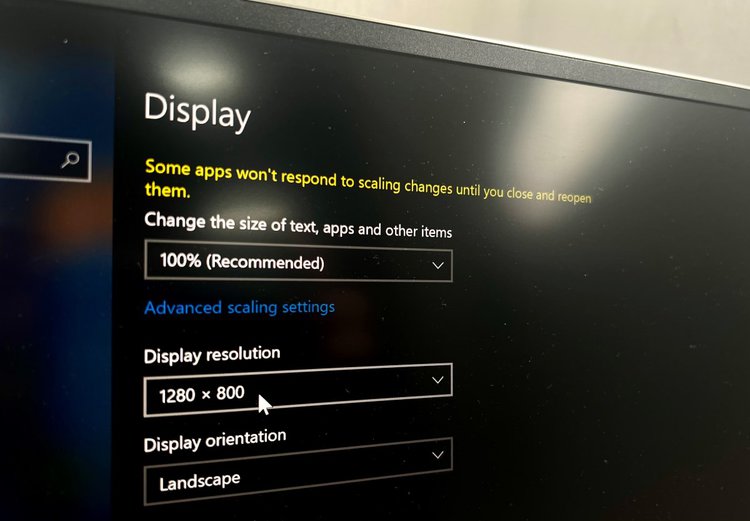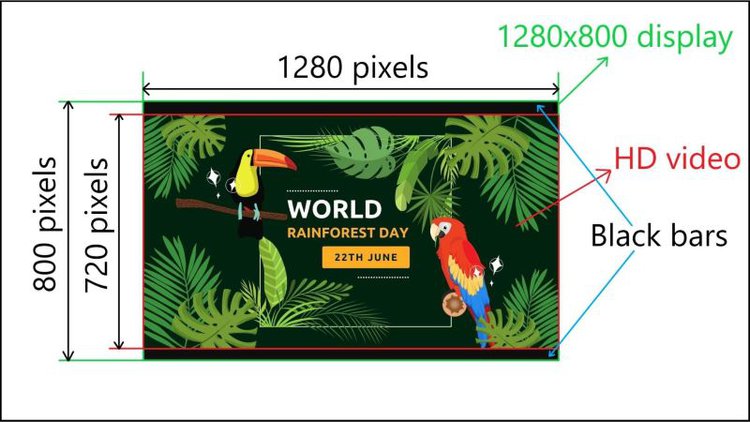1280×800 Resolution & Aspect Ratio, Explained

- The 1280×800 resolution (often referred to as WXGA) is distinct from the HD standard, which is 1280×720 pixels or 720p.
- The main differences between 1280×800 and HD are in height dimensions and aspect ratios, with 1280×800 having an aspect ratio of 16:10 while HD has 16:9.
- The 1280×800 resolution still offers good display quality, especially for reading on tablets and gaming devices like the Steam Deck.
Diving into the world of display technology, the “1280×800 resolution” stands out with its unique aspect ratio and its divergence from the standard HD.
This article will delve into the intricacies of the 1280×800 (WXGA) resolution, comparing its differences with HD, particularly in height dimensions and aspect ratios.
You’ll discover why, despite not being HD, 1280×800 still shines, especially in devices tailored for reading and gaming.
Quick Navigation
Can 1280×800 Resolution Be Considered HD Resolution?
No, the 1280×800 resolution can not be considered HD.
The 1280×800 resolution and HD are distinct resolution standards, each with its own specifications.
Moving from the discussion of whether 1280×800 resolution can be classified as HD, it is important to understand what exactly HD resolution is.
What Is HD Resolution?
When we dig into the topic of resolution, we are specifically referring to the pixel density present in both the horizontal and vertical directions of a display.
Increasing the pixel count directly correlates with achieving sharper and more intricate images on the display.
Consequently, a higher number of pixels results in superior image quality, delivering enhanced clarity and finer details to the viewer’s delight.
For example, a 4K display has 8,294,400 pixels, and an FHD display has 2,073,600 pixels. So the 4K display will have better image quality than the FHD display.
Watch the below video for a demonstration:
The display resolution is defined in pixels as width×height. For instance, 352×240 indicates that the width is 352 pixels and the height is 240 pixels.
HD (High Definition) resolution is 1280×720 pixels. The HD resolution can also be called 720p.
What Is 1280×800 Resolution?
As you can probably guess from the above resolution definition, the 1280×800 resolution is 1280×800 pixels.
Did you know that the 1280×800 resolution is sometimes referred to as WXGA (Wide Extended Graphics Array)? Back in the 2000s, WXGA was widely used for laptop screens.
The WXGA is an IBM display standard introduced in 1990, along which other standards: XGA, XGA+, WXGA+, WSXGA, SXGA, etc.
If you want to learn more about these standards and what they mean, you can find additional information here.
Why Is 1280×800 Resolution Not Considered HD?
There are two main reasons why the 1280×800 resolution is not considered to be HD: different height dimensions and different aspect ratios.
Different Height Dimension
The 1280×800 and HD resolutions have the same number of pixels in their width dimensions (1280 pixels), but different pixels in their height dimensions (1280×800 has 800 pixels while HD has 720 pixels).
Different Aspect Ratio
The aspect ratio is all about the balanced correlation between the actual width and height of the display.
You can think of the aspect ratio as a pair of numbers separated by a colon (x:y), where “x” represents the width and “y” represents the height.
To gain further insight into the aspect ratio, you can read our article here.
The 1280×800 aspect ratio is the outcome of a dividend of 1280 pixels with 800 pixels (the width and height pixel dimensions of the 1280×800 resolution), which results in 16:10.
The HD aspect ratio is the outcome of a dividend of 1280 pixels with 720 pixels (the width and height pixel dimensions of HD resolution), which results in 16:9.
So, 1280×800 and HD resolutions have different aspect ratios.
Is the 1280×800 Resolution Good?
Yes, the 1280×800 resolution is still a good resolution.
Can Display HD Videos Flawlessly
Although 1280×800 resolution is not considered to be HD, a 1280×800 resolution display can still play HD videos in native resolution with two black bars on the display like below.
A native resolution ensures that images remain undistorted and true to their original proportions.
The presence of these black bars is a result of the distinct aspect ratio.
The 1280×800 resolution has a 16:10 ratio, making it slightly taller than the HD (1280×720) resolution, which has a 16:9 aspect ratio. This means the 1280×800 display has an extra 80 pixels in height compared to HD videos.
1280×800 Resolution for Tablets
The combination of the 1280×800 resolution and the 16:10 aspect ratio is commonly featured in various Android tablets, including popular models like the Lenovo Yoga Tab 3, ASUS ZenPad 10, and Samsung Galaxy Tab A.
This particular design proves ideal for reading books because many printed papers share a similar aspect ratio close to 16:10. For example, ISO 216 papers adopt a 1.414:1 aspect ratio, aligning well with the display’s proportions.
1280×800 Resolution for Gaming
Back in 2021, Valve announced the Steam Deck, a super cool handheld gaming computer. It comes packed with a 7-inch display, rocking a 1280×800 resolution and a sweet 16:10 aspect ratio.
Many Reddit users found the 1280×800 resolution display on the Steam Deck outputs sharp, clear, and vibrant images.
Watch the below video for a demonstration:
Wrapping Things Up
In conclusion, while the 1280×800 resolution may not meet the criteria to be considered HD, it still offers a good level of display quality for certain purposes.
Its compatibility with reading books on tablets, as well as its performance in gaming devices like the Steam Deck, demonstrates its practicality and versatility.
Despite the differences in aspect ratios and pixel dimensions, a 1280×800 resolution display can flawlessly play HD videos in their native format, albeit with two black bars on the screen.
Understanding the nuances of resolution standards allows us to make informed choices when selecting displays that best suit our specific needs.
Whether it’s for work, entertainment, or leisure, the 1280×800 resolution continues to find its place in the world of visual technology.
Meet Vance. He’s a proud dad, a seasoned Electronics Engineer, and an avid tech lover. His proficiency in electronics and troubleshooting skills were instrumental in crafting Pointer Clicker. Vance is passionate about simplifying tech for those who aren’t well-versed in it.

